Affiliate disclosure: This post may contain affiliate links. Please see our Privacy Policy.
Canning beans is an easy way to prepare quick weeknight meals in advance. Home-canned beans taste infinitely better than storebought tinned beans, and it takes about the same amount of time to can them as it does to cook them. Make a big batch, and you’ve got dozens of quick meals just waiting in your pantry.
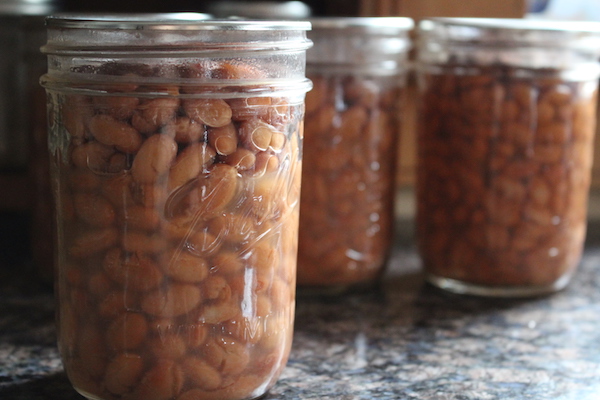
We eat a lot of beans. Like literally bucket loads of beans.
To save money, we started buying pinto beans and black beans in bulk from our local food coop, by the 25 and 50-pound sack. I’d store the dry beans in 5-gallon buckets sealed with airtight gamma seal lids, and stored that way they’ll keep a long time.
Years, in fact, even decades. But they never last more than a few months at my house.
The problem is, it takes a lot of time and energy to cook dry beans. Every other week I’d cook up a big pot of beans for our meals throughout the week, spending half the day steaming up the house. Then they’d take up half the fridge until we ate them all.
I figured that there had to be a better way, and there is!
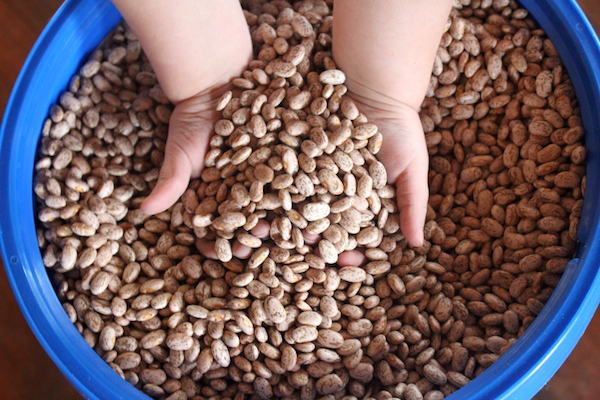
We already pressure can bone broth on a regular basis, so I’m no stranger to a pressure canner. Given that dry beans store well on their own, it just never seemed to make sense to can them.
After my first batch, I was hooked. It takes about the same amount of time to can beans at home as it does to cook them, and instead of them taking up the whole fridge they’re not neatly stored in meal-sized portions on my pantry shelf!
Home-canned beans cost just pennies a jar, and they taste a lot better than storebought canned beans. Now that I’ve started canning beans at home, that takes care of my family’s bean habit for next to nothing cost-wise and the process is incredibly simple.
How to Can Dry Beans
The process sounds complicated if you’ve never pressure canned before, but I promise it’s not all that hard.
Here are the basic steps:
- Soak the beans overnight (12-24 hours)
- Strain and add fresh water to a pot with the beans
- Bring to a boil and simmer 30 minutes while you prepare your pressure canner.
- Pack the partially cooked beans into canning jars, seal with 2 part canning lids and load into your pressure canner.
- Process the beans in the pressure canner for 75 minutes (pints) or 90 minutes (quarts). Pressure will depend on your altitude, and I’ll discuss that shortly.
- Turn off the heat and allow the canner to come to room temperature before unloading. Check jar seals, and store sealed jars in the pantry until needed.
Preparing Dry Beans for Canning
The first step in canning beans is soaking the beans.
This serves a couple of purposes. First, it helps to leach out compounds in the beans (indigestible starches) that cause gas. People are divided on this, and many don’t think it helps, but with my bean-eating family I can tell you it makes a world of difference.
Even if you don’t believe soaking beans is necessary generally, it is mandatory if you’re canning beans. The beans need to absorb as much water as possible before canning so that they don’t expand too much in the canning jar.
Start with a 12 to 24-hour soak in cool water.
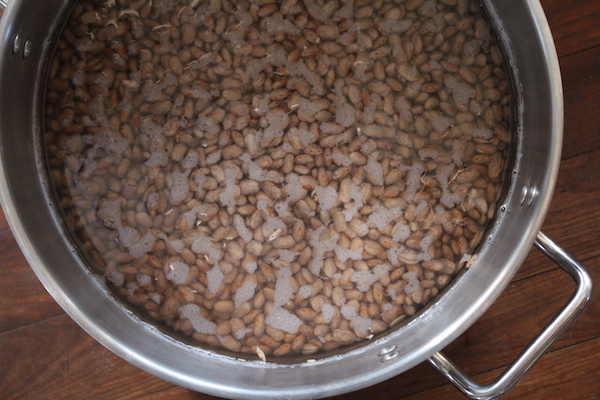
How Many Dry Beans fit in a Canner Batch?
The obvious next question is, how many beans do you need to soak for a canner batch?
I’ve found it takes 8 pounds of dry pinto beans to fill a 14-quart canner batch in my 30 Quart All American Canner. That works out to a bit over 1/2 pound of dry beans per quart jar (about 0.6 lbs).
The national center for food preservation recommends 5 pounds for a 7-quart batch, and 10 pounds for a 14-quart batch. I’ve found that’s way too much, and I end up what a huge pot of leftover beans. Not the end of the world, I just keep cooking them on the stove while the pressure canner is running, but then I’ve got about 12-15 cups of cooked beans in the fridge (on top of a full canner batch in the pantry).
If you’re canning beans in pints, the total amount is a bit less. These days, with a family of 4 I tend to can in quarts because it’s a lot more efficient.
My canner will hold 19 narrow mouth pints (or 18 wide mouth), but it’ll hold 14-quart jars. Canning in quarts means I can put up a lot more food faster, and we eat a quart per meal anyway.
I’ve written the recipe below for a standard canner batch of 7 quarts. I use a larger canner that can accommodate 14 quarts at a time, so I start with double the beans (8 lbs total).
For a standard canner batch of 9 pints, start with roughly 2 3/4 to 3 pounds of beans. In my canner, a pint batch is 19 narrow mouth pints and I use 5 1/2 to 6 pounds of dry beans.
If you don’t have a scale, a pound of beans is roughly 2 cups. That means that you need a heaping cup of dry beans for each quart jar.
Pre-Cooking Beans for Canning
I know what you’re thinking.
Why on earth do you need to partially cook the beans if you’re going to be putting them into a pressure canner?
The pre-cooking step is less about “cooking” and more about getting them to their final cooked size. By first soaking the beans for at least 12 hours, and then simmering them for about 30 minutes, they absorb water and reach their final cooked size.
This will help keep them from expanding too much in the canning jars. Or, more specifically, absorbing all of their canning jar liquid leaving them in a dry jar.
Even still, they’re going to absorb some water inside their canning jars when you take the jars out of the pressure canner the water level will have dropped. Here’s an example…
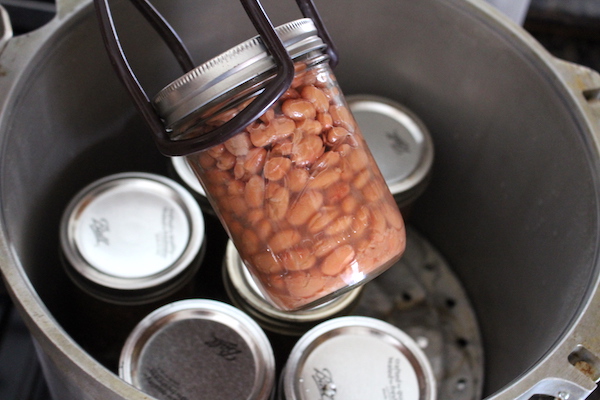
That’s some water level drop is perfectly fine in the jar, but a pre-cooking ensures that the beans will be fully cooked during the canning process and that they have enough water in a given jar to finish their cook while canning.
Strain out the soaking water. This will remove the starches they’ve released during soaking and result in higher quality home-canned beans.
Fill a large pot with water and add the soaked beans into the pot. Bring the pot to a boil and simmer the beans for 30 minutes to partially pre-cook them before canning.
Loading the Pressure Canner
While your beans are pre-cooking, prepare the pressure canner.
Follow the instructions that come from the manufacturer, as pressure canners sometimes have slightly different steps required based on the model.
For my All American Pressure Canner, I start by adding a thin coat of oil to the rim of the lid to ensure a good metal on metal seal at the top.
Then I add 2-3 inches of water to the bottom, along with the bottom trivet, and bring it to a boil alongside the pot that’s pre-cooking the beans.
I’ll also prepare canning jars, making sure I have enough jars and lids on the counter ready to go.
When the beans have finished their 30-minute pre-cook, use a canning funnel to load them into the canning jars leaving 1-inch headspace. Cover the beans with boiling cooking water before sealing with 2 part canning lids and loading into the pressure canner.
(Sometimes it helps to have a kettle of water boiling on the side just in case there’s not enough cooking liquid to fill the jars.)
Pressure Canning Dry Beans
Once the beans have been loaded into the pressure canner, seal up the lid according to the manufacturer’s instructions.
For mine, I tighten all the bolts and then allow the unit to steam out the vent pipe for 10 minutes before adding the canning weight. This ensures that the chamber is completely filled with steam and will heat to an even temperature (without any colder air pockets).
After steam release, I add the canning weight to the pressure appropriate for my altitude and then process for 75 minutes for pints or 90 minutes for quarts.
Pounds Pressure for Canning Beans
The total pounds pressure required varies based on your altitude, and whether you’re using a weighted gauge or dial gauge pressure canner. I use a weighted gauge, which is much easier to work with, but it only has 3 pressure settings (5, 10, and 15 lbs).
Use the table below to determine the appropriate canning pressure based on your altitude and the canner you’re using.
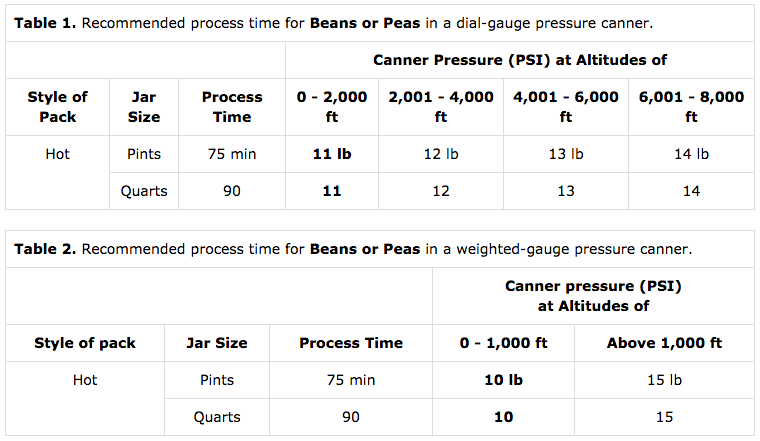
Checking Seals and Storage
After the processing time is over, turn off the heat, and allow the pressure canner to come to room temperature before opening.
Once cooled, I remove the jars from the canner check their seals and give them a quick rinse in the sink.
Remove the canning rings. They’re no longer holding the lids on the jars because the jars should be completely vacuum-sealed. If a jar’s not sealed to the point where the ring is pointless, then it’s not properly canned. The ring is only there to hold the lid in place during canning, not during storage.
Leaving the rings on might actually cause trouble, because they may trap water/bean juice underneath which can either mold (nasty) or simply rust the jar lid shut. Either way, while the beans inside may still be perfectly fine, it makes it hard to get to them. Much easier to remove the rings after canning and save yourself frustration later.
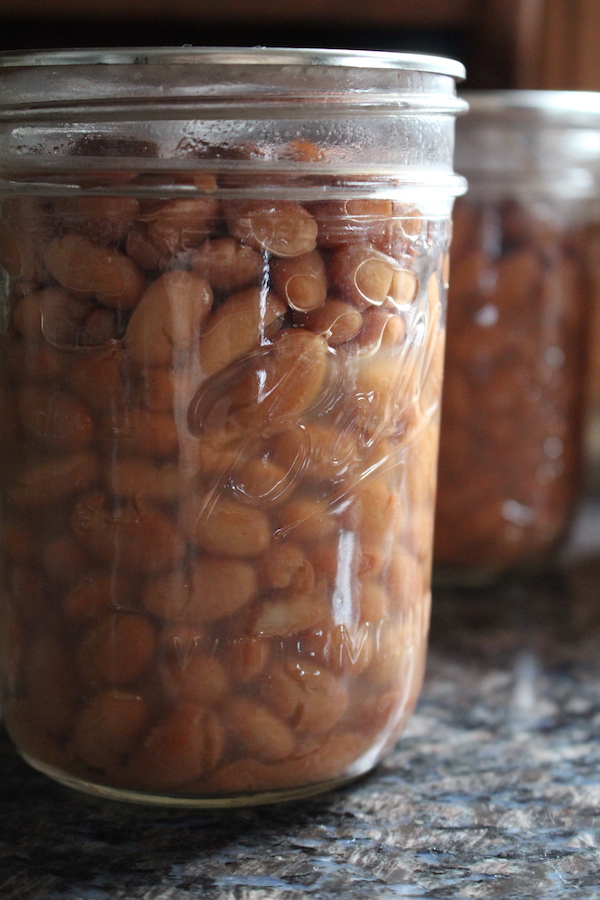
How Long do Canned Beans Last?
General recommendations suggest eating home-canned goods within 1 year. Ball canning recently revised those guidelines using their modern lids, and they now suggest quality will be maintained for 18 months.
After 12-18 months, the canned goods will begin to degrade in quality, but they may be safe for much longer than that initial storage period. You’ll have to use your best judgment.
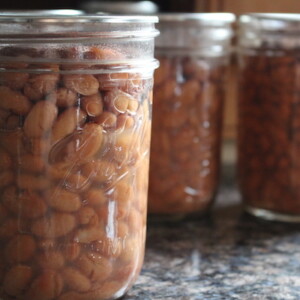
Canning Beans
Equipment
- Pressure Canner
Ingredients
- 4 Pounds Dry Beans, about 8 cups
- Water
- Salt, Optional, see note
Instructions
- Pick over dried beans, removing any discolored beans or non-bean debris.
- Place the beans in a large pot or bowl and cover with cool water. Allow the beans to soak for 12-24 hours, ensuring that they always stay submerged.
- Drain the soaking water.
- Place beans in a large stockpot with fresh water. Bring the pot to a boil and cook 30 minutes.
- While the beans are cooking, prepare a pressure canner according to the manufacturer's instructions. (This usually means adding the bottom trivet and heating 2-3 inches of water in the bottom.)
- Put a kettle of water on and bring to a boil. (This will help top off the liquid in the jars if there's not enough water in the bean pot.)
- Hot pack the partially cooked beans into quart or pint jars. Top with boiling water, either from the bean pot or from the kettle. Be sure to leave 1-inch headspace.
- If adding salt, use 1/2 tsp per pint or 1 teaspoon per quart (optional, adjust to your taste).
- Seal jars with 2 part canning lids and load them into the pressure canner, following the manufacturer's instructions on loading/spacing/etc.
- Place the lid on the pressure canner and secure it. Allow the unit to vent steam for 10 minutes before adding the pressure weight to allow it to begin pressurizing.
- Process jars at pressure for 75 minutes (pints) or 90 minutes (quarts) for locations under 1000 feet in elevation. Be sure to adjust times based on your elevation. (Wait until the unit is up to pressure before starting a timer.)
- Once the processing time is over, turn off the heat and allow the unit to come to room temperature before opening (this can be several hours, I usually let it sit overnight).
- Unload the canner and check seals. Store any unsealed jars in the refrigerator for immediate use.
- Remove canning bands from sealed jars, and clean off the outsides before storing in the pantry.
- Home-canned beans should last 12-18 months in the pantry if properly canned and sealed.
Notes
Pressure Canning Recipes
Looking for more pressure canner recipes to keep your canning weight rocking?
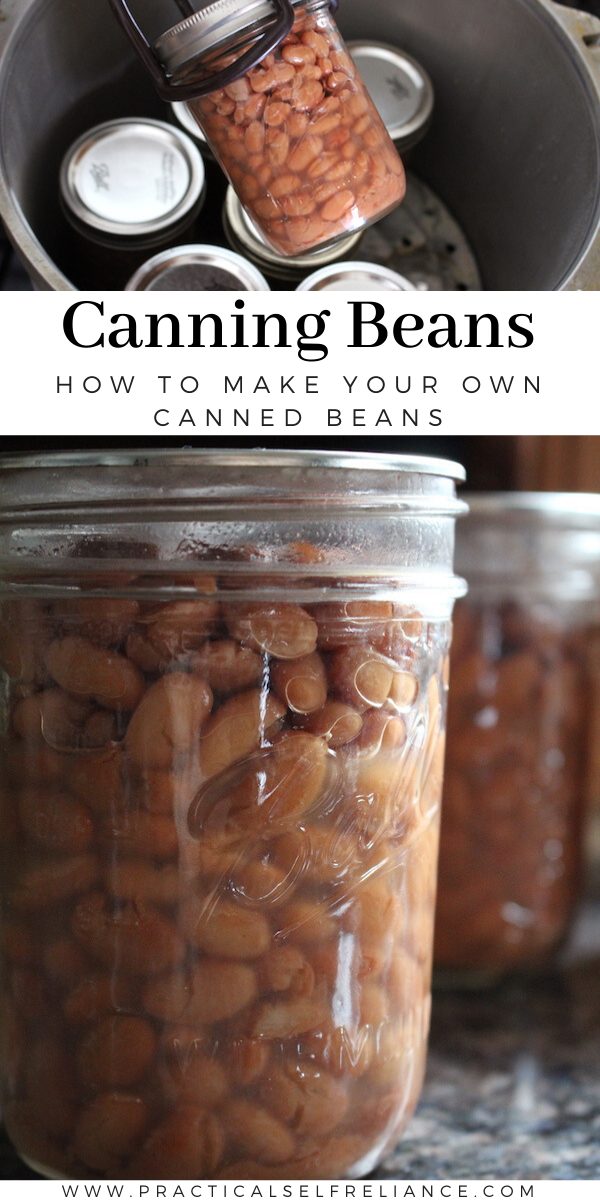
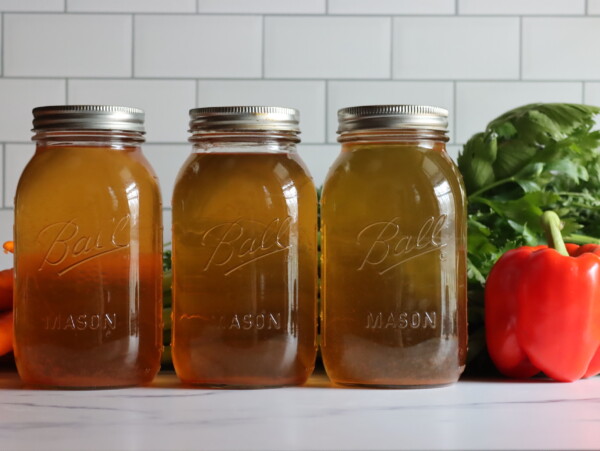
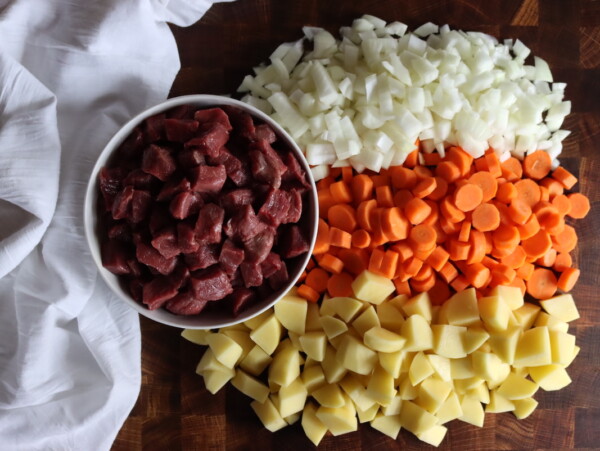
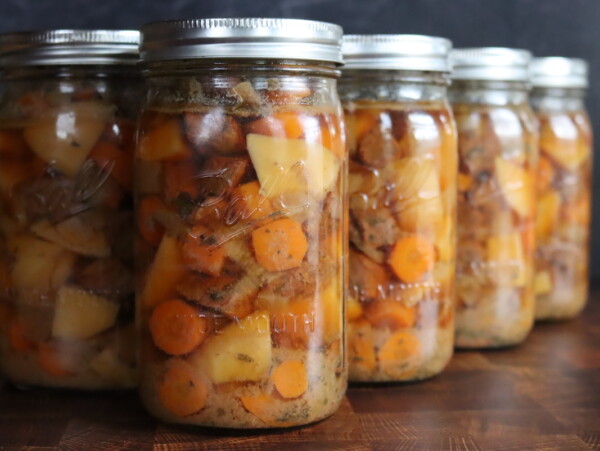
Hi Ashley, as I think about the variety of beans I’d like to prepare, I’m mindful that navy in the traditional way of cooking them, some take little time and some take longer. What is your guidance of “time to cook” in both the stovetop phase and the canner phase? Thanks once again! Karen
You’re right, beans do really vary in cook time on the stove. I’ve found that they always come out just fine when canned in jars, more or less regardless of the type of bean. Counter intuitive, I know. I always do an overnight soak, and then pre-cook for 30 minutes, regardless of bean type. Hope this helps!
Hi Ashley, this article is brilliant. It’s a total “how to” story for the true beginner. I look forward to this adventure in beans, as we join your family in consuming so many during the winter….Thank you and keep up the great and accessible writing!
Karen in NH
So glad it was helpful to you!
Jen, what if your water is already alkaline?
Ramona, I’ve heard the same thing and will try it the next time I can beans.